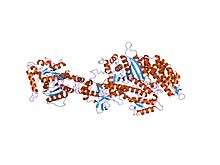Dynamin
| Dynamin family | |||||||||
|---|---|---|---|---|---|---|---|---|---|
 Structure of the nucleotide-free myosin II motor domain from Dictyostelium discoideum fused to the GTPase domain of dynamin I from Rattus norvegicus | |||||||||
| Identifiers | |||||||||
| Symbol | Dynamin_N | ||||||||
| Pfam | PF00350 | ||||||||
| Pfam clan | CL0023 | ||||||||
| InterPro | IPR001401 | ||||||||
| PROSITE | PDOC00362 | ||||||||
| |||||||||
| Dynamin central region | |||||||||
|---|---|---|---|---|---|---|---|---|---|
 Structure of the nucleotide-free myosin II motor domain from Dictyostelium discoideum fused to the GTPase domain of dynamin I from Rattus norvegicus | |||||||||
| Identifiers | |||||||||
| Symbol | Dynamin_M | ||||||||
| Pfam | PF01031 | ||||||||
| InterPro | IPR000375 | ||||||||
| |||||||||
Dynamin is a GTPase responsible for endocytosis in the eukaryotic cell. Dynamins are principally involved in the scission of newly formed vesicles from the membrane of one cellular compartment and their targeting to, and fusion with, another compartment, both at the cell surface (particularly caveolae internalization) as well as at the Golgi apparatus.[1][2][3] Dynamin also plays a role in many processes including division of organelles,[4] cytokinesis and microbial pathogen resistance.
Dynamin is part of the "dynamin superfamily," which includes classical dynamins, dynamin-like proteins, Mx proteins, OPA, mitofusins, and GBPs. Dynamin itself is a 96 kDa enzyme, and was first isolated when researchers were attempting to isolate new microtubule-based motors from the bovine brain. Dynamin has been extensively studied in the context of clathrin-coated vesicle budding from the cell membrane.[3][5]
Function
As a vesicle invaginates, dynamin forms a spiral around the neck of the vesicle. Once the spiral is in place, it extends lengthwise and constricts through GTP hydrolysis. This lengthening and tightening of the coil around the vesicle neck causes it to break and results in the pinching off of the vesicle from the parent membrane. An example of a vesicle is a clathrin-coated pit.[2][5]
To view a ‘cartoon’ image of the non-constricted and constricted state of dynamin spirals, please follow this link: http://dynamin.niddk.nih.gov/figure5.html.[2] The first structure on the left is dynamin in its relaxed state. The structure on the right is dynamin in its constricted state. This shows the extent to which dynamin tightens and changes when GTP is converted to GDP.[1]
This constriction is in part the result of the twisting activity of dynamin.[6] This twisting required GTP hydrolysis. Dynamin is the only molecular motor known to have a twisting activity. Dynamin is a right-handed helix and has a right-handed twisting activity that explains its tightening and the reduction in the pitch of the helix described above.
Types
In mammals, three different dynamin genes have been identified:
- Dynamin I is expressed in neurons and neuroendocrine cells
- Dynamin II is expressed in most cell types
- Dynamin III is strongly expressed in the testis, but is also present in heart, brain, and lung tissue.[1][5]
Disease implications
Mutations in Dynamin II have been found to cause dominant intermediate Charcot-Marie-Tooth disease.[7] Epileptic encephalopathy–causing de novo mutations in dynamin have been suggested to cause dysfunction of vesicle scission during synaptic vesicle endocytosis.[8]
References
- 1 2 3 Henley, J.R.; Cao, H.; McNicven, M.A. (1999). "Participation of dynamin in the biogenesis of cytoplasmic vesicles". The FASEB Journal. 13 (9002): S243–S247.
- 1 2 3 Hinshaw, J. “Research statement, Jenny E. Hinshaw, Ph.D.” National Institute of Diabetes & Digestive & Kidney Diseases, Laboratory of Cell Biochemistry and Biology. Accessed 19 March 2013.
- 1 2 Urrutia, R.; Henley, J.R.; Cook, T.; McNiven, M.A. (1997). "The dynamins: Redundant or distinct functions for an expanding family of related GTPases?". Proc. Natl. Acad. Sci. USA. 94 (2): 377–384. doi:10.1073/pnas.94.2.377.
- ↑ Thoms S, Erdmann R (Oct 2005). "Dynamin-related proteins and Pex11 proteins in peroxisome division and proliferation.". FEBS J. 272 (20): 5169–81. doi:10.1111/j.1742-4658.2005.04939.x. PMID 16218949.
- 1 2 3 McMahon. (2004). Researching Endocytic Mechanisms: Dynamin. Accompaniment to Nature Reviews Molecular Cell Biology, 5, 133-147.
- ↑ Roux, A; Uyhazi, K; Frost, A; De Camilli, P (2006-04-30). "GTP-dependent twisting of dynamin implicates constriction and tension in membrane fission". Nature. 441 (7092): 528–31. doi:10.1038/nature04718. PMID 16648839.
- ↑ Stephan Zuchner, Maher Noureddine, Marina Kennerson, Kristien Verhoeven, Kristl Claeys, Peter De Jonghe, John Merory, Sofia A. Oliveira, Marcy C. Speer, Judith E. Stenger, Gina Walizada, Danqing Zhu, Margaret A. Pericak-Vance, Garth Nicholson, Vincent Timmerman & Jeffery M. Vance (March 2005). "Mutations in the pleckstrin homology domain of dynamin 2 cause dominant intermediate Charcot-Marie-Tooth disease". Nature Genetics. 37 (3): 289–294. doi:10.1038/ng1514. PMID 15731758.
- ↑ Dhindsa, R; Bradrick, S; Yao, Y; Heinzen, E; Petrovski, S; Krueger, B; Johnson, M; Frankel, F; Petrou, S; Boumil, R; Goldstein, D (2015-06-15). "Epileptic encephalopathy-causing mutations in DNM1 impair synaptic vesicle endocytosis". Neurology Genetics. 1 (1): 3–9.
External links
| Wikimedia Commons has media related to Dynamins. |
- Dynamins at the US National Library of Medicine Medical Subject Headings (MeSH)